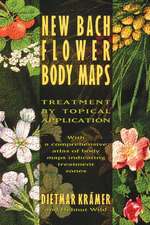Acupressure Taping: The Practice of Acutaping for Chronic Pain and Injuries
Autor Hans-Ulrich Hecker M.D., Kay Liebchen M.D.en Limba Engleză Paperback – 23 apr 2007
Preț: 128.71 lei
Nou
Puncte Express: 193
Preț estimativ în valută:
24.63€ • 25.62$ • 20.64£
24.63€ • 25.62$ • 20.64£
Carte disponibilă
Livrare economică 20 februarie-06 martie
Livrare express 06-12 februarie pentru 24.94 lei
Preluare comenzi: 021 569.72.76
Specificații
ISBN-13: 9781594771484
ISBN-10: 1594771480
Pagini: 128
Ilustrații: 117 four-color illustrations
Dimensiuni: 203 x 254 x 8 mm
Greutate: 0.36 kg
Ediția:1
Editura: Inner Traditions/Bear & Company
Colecția Healing Arts Press
Locul publicării:United States
ISBN-10: 1594771480
Pagini: 128
Ilustrații: 117 four-color illustrations
Dimensiuni: 203 x 254 x 8 mm
Greutate: 0.36 kg
Ediția:1
Editura: Inner Traditions/Bear & Company
Colecția Healing Arts Press
Locul publicării:United States
Notă biografică
Hans-Ulrich Hecker, M.D., is an internationally known expert in acupuncture and Chinese medicine. He is a lecturer in naturopathy and acupuncture at the University of Schleswig-Holstein in Germany and the author of numerous books translated into many languages. Kay Liebchen, M.D., is an orthopedist who specializes in pain therapy, acupuncture, and acutaping. He teaches chirotherapy at the Dr. Karl Sell Medical Seminar and is the coauthor of numerous textbooks. The authors live in Germany.
Extras
Acupressure Taping: A New Therapeutic Method
Acupressure taping is a new therapeutic method that uses flexible tape bandages on the basis of the theory of acupuncture.
The word acupressure combines the prefix “acu-” from the word acupuncture and the word pressure. An acupressure massage therapist uses finger pressure on the same points in which an acupuncturist inserts needles. In acupressure taping, the elastic tape applies subtle pressure to the taped area, often stimulating acupuncture points related to the area where the patient feels pain. The term “acupressure taping” thus indicates that this is a new therapeutic method that establishes a connection between the theory of acupuncture and the practice of kinesio-taping.
The difference between kinesio-taping and acupressure taping can be explained in this fashion: In kinesio-taping, the tapes are attached to the immediate area of a muscle, ligament, or joint that is in pain. In acupressure taping, along with these specific anatomical aspects at the locus of pain, the diagnostic and therapeutic rules of traditional Chinese medicine and acupuncture, as well as the manual medical approach of osteopathy, also are taken into consideration when placing the tapes. When these holistic methods of understanding are applied to the tape placements, the specific areas of the body that are taped may not necessarily be perceived as problem areas by the patient, yet tensions or blocked energy in these areas may be considered to have, in fact, an important causal relationship to the disorders or pain actually felt in other parts of the body.
Unlike conventional medicine, which uses tape as nonelastic, restrictive bandages for the purpose of binding and immobilizing joints, acupressure taping does not inhibit freedom of movement.
12. Cervical Spine Tape
Ailments
~ Pain in the area of the cervical spine
~ Headaches
~ Dizziness
~ Ringing in the ear (tinnitus)
~ Pain in the area of the elbow
~ Tennis elbow
~ Golfer’s elbow
~ Pain in the area of the wrist
~ Carpal tunnel syndrome (numbness in the area of the hand)
Number and Length of Tapes
Number of Tapes: 2
Measuring the Tape:
~ First strip of tape: Runs from the upper thoracic spine to the hairline.
Important: Three quarters of the length of the tape should be cut down the middle with a pair of scissors. Both ends should be rounded off.
~ Second strip of tape: Runs from the middle of the right shoulder, across the back just below the neck, to the middle of the left shoulder.
Important: Fold the second strip of tape at the halfway point of its length and crease it well so that you can clearly see its middle point.
Tip: Do a preliminary stretching of the muscles and joints so you can measure the length of the tape strips exactly.
Preliminary Stretching and Attachment of the Tape
Preliminary Stretching
~ Bend your head forward with your chin reaching as far as possible toward the breastbone, which will make the vertebral process at the base of the cervical spine visible.
Attaching the Tape
~ Attach the first strip of tape at the upper part of the thoracic spine, beginning with the uncut end. Attach the left portion of the cut strip of tape on the left side of the spine up to the hairline, slightly left of center.
~ Attach the right portion of the cut tape on the right side of the spine up to the hairline, slightly right of center.
~ Attach the second strip of tape across the first strip at the transition from the cervical spine to the thoracic spine. The vertebral process of the cervical spine can be seen or felt easily as described in the preliminary stretching instructions. Use the middle fold on the second strip of tape to center it on the vertebral process. Attach the tape in a curve running right and left to the middle of each shoulder.
Please Note
~ The transition points between the different regions of the spine are prone to disorders, so it is important that the second strip of tape completely cover the area of transition from the cervical spine to the thoracic spine.
~ The cervical spine tape can also be used with the two strips of cervical spine lymph tape.
Acupressure taping is a new therapeutic method that uses flexible tape bandages on the basis of the theory of acupuncture.
The word acupressure combines the prefix “acu-” from the word acupuncture and the word pressure. An acupressure massage therapist uses finger pressure on the same points in which an acupuncturist inserts needles. In acupressure taping, the elastic tape applies subtle pressure to the taped area, often stimulating acupuncture points related to the area where the patient feels pain. The term “acupressure taping” thus indicates that this is a new therapeutic method that establishes a connection between the theory of acupuncture and the practice of kinesio-taping.
The difference between kinesio-taping and acupressure taping can be explained in this fashion: In kinesio-taping, the tapes are attached to the immediate area of a muscle, ligament, or joint that is in pain. In acupressure taping, along with these specific anatomical aspects at the locus of pain, the diagnostic and therapeutic rules of traditional Chinese medicine and acupuncture, as well as the manual medical approach of osteopathy, also are taken into consideration when placing the tapes. When these holistic methods of understanding are applied to the tape placements, the specific areas of the body that are taped may not necessarily be perceived as problem areas by the patient, yet tensions or blocked energy in these areas may be considered to have, in fact, an important causal relationship to the disorders or pain actually felt in other parts of the body.
Unlike conventional medicine, which uses tape as nonelastic, restrictive bandages for the purpose of binding and immobilizing joints, acupressure taping does not inhibit freedom of movement.
12. Cervical Spine Tape
Ailments
~ Pain in the area of the cervical spine
~ Headaches
~ Dizziness
~ Ringing in the ear (tinnitus)
~ Pain in the area of the elbow
~ Tennis elbow
~ Golfer’s elbow
~ Pain in the area of the wrist
~ Carpal tunnel syndrome (numbness in the area of the hand)
Number and Length of Tapes
Number of Tapes: 2
Measuring the Tape:
~ First strip of tape: Runs from the upper thoracic spine to the hairline.
Important: Three quarters of the length of the tape should be cut down the middle with a pair of scissors. Both ends should be rounded off.
~ Second strip of tape: Runs from the middle of the right shoulder, across the back just below the neck, to the middle of the left shoulder.
Important: Fold the second strip of tape at the halfway point of its length and crease it well so that you can clearly see its middle point.
Tip: Do a preliminary stretching of the muscles and joints so you can measure the length of the tape strips exactly.
Preliminary Stretching and Attachment of the Tape
Preliminary Stretching
~ Bend your head forward with your chin reaching as far as possible toward the breastbone, which will make the vertebral process at the base of the cervical spine visible.
Attaching the Tape
~ Attach the first strip of tape at the upper part of the thoracic spine, beginning with the uncut end. Attach the left portion of the cut strip of tape on the left side of the spine up to the hairline, slightly left of center.
~ Attach the right portion of the cut tape on the right side of the spine up to the hairline, slightly right of center.
~ Attach the second strip of tape across the first strip at the transition from the cervical spine to the thoracic spine. The vertebral process of the cervical spine can be seen or felt easily as described in the preliminary stretching instructions. Use the middle fold on the second strip of tape to center it on the vertebral process. Attach the tape in a curve running right and left to the middle of each shoulder.
Please Note
~ The transition points between the different regions of the spine are prone to disorders, so it is important that the second strip of tape completely cover the area of transition from the cervical spine to the thoracic spine.
~ The cervical spine tape can also be used with the two strips of cervical spine lymph tape.
Cuprins
Introduction
PART 1: WHAT IS ACUTAPING?
Acutaping: A New Therapeutic Method
The Foundation: Kinesio-Taping
What Is the Basis of Acutaping?
The Influence of Chinese Medicine
The Influence of Acupuncture
The Influence of Manual Medicine and Osteopathy
How Does Acutaping Work?
Examples of Acutaping Therapy
Who Can Benefit from Acutaping?
Various Indications for the Effective Use of Acutaping
Against What Sort of Pain Is Acutaping Effective?
Acutaping in Sports Medicine
When Not to Use Acutaping
Complex or Structural Disorders
Other Factors Pertaining to a Disorder
When Acutaping Is Not Advised
Acutape: Information and Tips
Description of the Acutape
Some Practical Tips
Acutape Colors
What Areas of the Body Can Be Treated?
Duration of Therapy
How To Prevent Failure
A Sightseeing Tour around the Human Body
Head, Chest, Abdominal, and Pelvic Regions
The Arms
The Legs
PART 2: HOW TO USE ACUTAPE
1. Finger and Forearm Extensor Tape
2. Finger and Forearm Flexor Tape
3. Thumb Saddle Joint Tape
4. Elbow Joint Extensor Tape
5. Elbow Joint Flexor Tape
6. Pectoral Muscle Tape
7. Trapezius Muscle Tape
8. Levator Scapula Muscle Tape
9. Rotator Cuff Muscle Tape
10. Levator Costarum (or Scalenus) Muscle Tape
11. Rhomboid Muscle Tape
12. Cervical Spine Tape
13. Cervical Spine Lymph Tape
14. Thoracic Spine Tape
15. Lumbar Spine Tape
16. Lumbar Spine Star Tape
17. Sacroiliac Joint Tape
18. Abdominal Muscle Tape (Rectus Abdominus)
19. Abdominal Muscle Tape (Oblique Muscles)
20. Pelvic Bone Muscle Tape
21. Hip And Loin Flexor (Iliopsoas) Muscle Tape
22. Knee Tape
23. Combination Tape
24. Knee Flexor Tape
25. Achilles Tendon and Ankle Joint Tape
Appendix: Ailments From A to Z
Afterword
Sources of Acutape
Index
PART 1: WHAT IS ACUTAPING?
Acutaping: A New Therapeutic Method
The Foundation: Kinesio-Taping
What Is the Basis of Acutaping?
The Influence of Chinese Medicine
The Influence of Acupuncture
The Influence of Manual Medicine and Osteopathy
How Does Acutaping Work?
Examples of Acutaping Therapy
Who Can Benefit from Acutaping?
Various Indications for the Effective Use of Acutaping
Against What Sort of Pain Is Acutaping Effective?
Acutaping in Sports Medicine
When Not to Use Acutaping
Complex or Structural Disorders
Other Factors Pertaining to a Disorder
When Acutaping Is Not Advised
Acutape: Information and Tips
Description of the Acutape
Some Practical Tips
Acutape Colors
What Areas of the Body Can Be Treated?
Duration of Therapy
How To Prevent Failure
A Sightseeing Tour around the Human Body
Head, Chest, Abdominal, and Pelvic Regions
The Arms
The Legs
PART 2: HOW TO USE ACUTAPE
1. Finger and Forearm Extensor Tape
2. Finger and Forearm Flexor Tape
3. Thumb Saddle Joint Tape
4. Elbow Joint Extensor Tape
5. Elbow Joint Flexor Tape
6. Pectoral Muscle Tape
7. Trapezius Muscle Tape
8. Levator Scapula Muscle Tape
9. Rotator Cuff Muscle Tape
10. Levator Costarum (or Scalenus) Muscle Tape
11. Rhomboid Muscle Tape
12. Cervical Spine Tape
13. Cervical Spine Lymph Tape
14. Thoracic Spine Tape
15. Lumbar Spine Tape
16. Lumbar Spine Star Tape
17. Sacroiliac Joint Tape
18. Abdominal Muscle Tape (Rectus Abdominus)
19. Abdominal Muscle Tape (Oblique Muscles)
20. Pelvic Bone Muscle Tape
21. Hip And Loin Flexor (Iliopsoas) Muscle Tape
22. Knee Tape
23. Combination Tape
24. Knee Flexor Tape
25. Achilles Tendon and Ankle Joint Tape
Appendix: Ailments From A to Z
Afterword
Sources of Acutape
Index
Recenzii
"With straightforward diagnostic lists, easy instructions with tips, great color photographs, and an appendix of ailments, this guidebook will appeal to those interested in trying this conservative-care approach to pain management at home. It is also appropriate for healthcare professionals working with musculoskeletal problems. Recommended for acupuncture, massage, naturopathic, chiropractic, and osteopathic school libraries as well as for most public libraries."
"Here's a guide to a new method of pain treatment, acutaping, which offers an easier alternative . . . Any bodywork health library needs this."
"Here's a guide to a new method of pain treatment, acutaping, which offers an easier alternative . . . Any bodywork health library needs this."
Descriere
Combines acupressure and massage to treat pain using elastic tape.


























